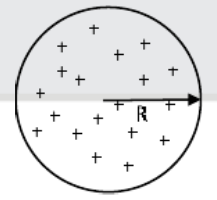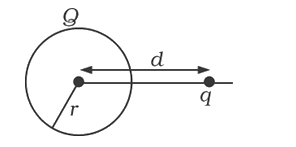A metallic sphere of radius R is cut in two parts along a plane whose minimum distance from the sphere's centre is h=R2 and the sphere is uniformly charges by a total charged by a total electric charge Q. The minimum force necessary (to be applied on each of the two parts) to hold the two parts of the sphere together is 3kQ2pR2. Then find the value of p ?
To solve the problem step by step, we will analyze the situation of the metallic sphere that is uniformly charged and cut into two parts. We will derive the minimum force necessary to hold the two parts together and find the value of p.
1. Understanding the Problem:
- We have a metallic sphere of radius R uniformly charged with total charge Q.
- The sphere is cut into two parts along a plane that is at a minimum distance h=R2 from the center of the sphere.
2. Identifying the Surface Charge Density:
- The surface charge density σ on the sphere can be calculated as:
σ=Q4πR2
- This is because the total charge Q is uniformly distributed over the surface area of the sphere, which is 4πR2.
3. Calculating the Electric Field:
- The electric field E at the surface of the sphere due to the charge Q is given by:
E=kQR2
- Here, k is Coulomb's constant.
4. Determining the Force on Each Half:
- When the sphere is cut, we need to find the force F required to hold the two halves together.
- Consider a small area element dS on one of the halves. The force dF acting on this area due to the electric field E is:
dF=σdSE
- Substituting σ and E:
dF=(Q4πR2)dS(kQR2)=kQ24πR4dS
5. Integrating Over the Surface:
- To find the total force F, we need to integrate dF over the area of the half-sphere that is still in contact:
F=∫dF=∫kQ24πR4dS
- The area A of the circular face of the cut (which is a circle with radius √R2−(R2)2=√3R24=√3R2) is:
A=π(√3R2)2=3πR24
6. Calculating the Total Force:
- Substituting the area into the force equation:
F=kQ24πR4⋅3πR24=3kQ216R2
7. Equating Forces:
- According to the problem statement, the force can also be expressed as:
F=3kQ2pR2
- Equating the two expressions for force:
3kQ216R2=3kQ2pR2
8. Solving for p:
- Canceling 3kQ2 from both sides:
116=1p⟹p=16
Final Answer:
The value of p is 16.
- We have a metallic sphere of radius R uniformly charged with total charge Q.
- The sphere is cut into two parts along a plane that is at a minimum distance h=R2 from the center of the sphere.
- The surface charge density σ on the sphere can be calculated as:
σ=Q4πR2
- This is because the total charge Q is uniformly distributed over the surface area of the sphere, which is 4πR2.
- The electric field E at the surface of the sphere due to the charge Q is given by:
E=kQR2
- Here, k is Coulomb's constant.
- When the sphere is cut, we need to find the force F required to hold the two halves together.
- Consider a small area element dS on one of the halves. The force dF acting on this area due to the electric field E is:
dF=σdSE
- Substituting σ and E:
dF=(Q4πR2)dS(kQR2)=kQ24πR4dS
- To find the total force F, we need to integrate dF over the area of the half-sphere that is still in contact:
F=∫dF=∫kQ24πR4dS
- The area A of the circular face of the cut (which is a circle with radius √R2−(R2)2=√3R24=√3R2) is:
A=π(√3R2)2=3πR24
- Substituting the area into the force equation:
F=kQ24πR4⋅3πR24=3kQ216R2
- According to the problem statement, the force can also be expressed as:
F=3kQ2pR2
- Equating the two expressions for force:
3kQ216R2=3kQ2pR2
- Canceling 3kQ2 from both sides:
116=1p⟹p=16
The value of p is 16.
Topper's Solved these Questions
- BOOK - AAKASH INSTITUTE ENGLISHCHAPTER - ELECTRIC CHARGES AND FIELDS EXERCISE - comprehension3videos
ELECTRIC CHARGES AND FIELDS
- BOOK - AAKASH INSTITUTE ENGLISHCHAPTER - ELECTRIC CHARGES AND FIELDS EXERCISE - SECTION-I(SUBJECTIVE TYPE QUESTIONS)2videos
ELECTRIC CHARGES AND FIELDS
- BOOK - AAKASH INSTITUTE ENGLISHCHAPTER - DUAL NATURE OF RADIATION AND MATTER EXERCISE - ASSIGNMENT (SECTION-D)10videos
DUAL NATURE OF RADIATION AND MATTER
- BOOK - AAKASH INSTITUTE ENGLISHCHAPTER - ELECTROMAGNETIC INDUCTIONEXERCISE - ASSIGNMENT(SECTION -D) Assertion-Reason type Question)15videos
ELECTROMAGNETIC INDUCTION
Similar Questions
Knowledge Check
- Question 1 - Select One
Metallic sphere of radius R is charged to potential V. Then charge q is proportional to
AVBRCboth V and RDnone of these
A conducting sphere of radius R is charged to a potential of V volts. Then the electric field at a distance r(>R) from the centre of the sphere would be
View SolutionCharge density of a sphere of radius R is ρ=ρ0r where r is distance from centre of sphere.Total charge of sphere will be
 View Solution
View SolutionA non-conducting solid sphere of radius R is uniformly charged. The magnitude of the electric filed due to the sphere at a distance r from its centre
View SolutionAn isolated solid metal sphere of radius R is given an electric charge. The variation of the intensity of the electric field with the distance r from the centre of the sphere is best shown by
View SolutionA hollow sphere of radius 2R is charged to V volts and another smaller sphere of radius R is charged to V/2 volts. Now the smaller sphere is placed inside the bigger sphere without changing the net charge on each sphere. The potential difference between the two spheres would be
View SolutionA solid conducting sphere of radius r is having a charge of Q and point charge q is a distance d from the centre of sphere as shown. The electric potential at the centre of the solid sphere is :
 View Solution
View SolutionA conducting sphere of radius R is given a charge Q. The electric potential and the electric field at the centre of the sphere respectively are
View Solution

